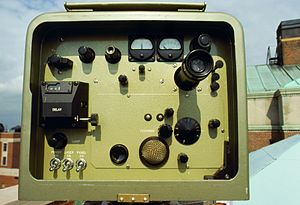Geodimeter: Difference between revisions
Content deleted Content added
describe electronics |
→Electronic mechanism: spell |
||
| Line 7: | Line 7: | ||
==Electronic mechanism== |
==Electronic mechanism== |
||
The mechanism uses a [[Kerr cell]] in an optical train that chops a collimated light beam under the control of a precision electronic oscillator in the |
The mechanism uses a [[Kerr cell]] in an optical train that chops a collimated light beam under the control of a precision electronic oscillator in the megahertz range.<ref> {{cite book|title=Geodimeter Manual|first=Austin C.|last=Poling|publisher=U.S. Coast and Geodetic Survey|id=Publication 62-2|year=1959|url= https://www.google.com/books/edition/Geodimeter_Manual/GdMGb4zyvTsC}}</ref> It is similar in principle to earlier mechanical choppers in [[Fizeau–Foucault apparatus]] that used a toothed wheel or a rotating mirror. |
||
==See also== |
==See also== |
||
Revision as of 03:17, 3 May 2021

The Geodimeter (acronym of geodetic distance meter) was the first optical electronic distance meter surveying instrument.[1][2] It was originally developed for measuring the speed of light.[3][4] It was invented in the 1940s by Erik Osten Bergstrand and commercialized in 1953 by the AGA (Aktiebolaget Gasaccumulator) company of Sweden.[5] It was used in the Transcontinental Traverse.
Electronic mechanism
The mechanism uses a Kerr cell in an optical train that chops a collimated light beam under the control of a precision electronic oscillator in the megahertz range.[6] It is similar in principle to earlier mechanical choppers in Fizeau–Foucault apparatus that used a toothed wheel or a rotating mirror.
See also
References
- ^ Rüeger, J.M. (2012). Electronic Distance Measurement: An Introduction. Springer Berlin Heidelberg. p. 15. ISBN 978-3-642-80233-1. Retrieved 2020-09-24.
- ^ Bergstrand, Erik (2008). "Distance measuring by means of modulated light". Bulletin Géodésique. 24 (1): 243–249. doi:10.1007/BF02526937. ISSN 0007-4632. S2CID 121587208.
- ^ Froome, K.D.; Essen, L. (1969). The Velocity of Light and Radio Waves. Academic Press. Retrieved 2020-09-24.
- ^ Bergstrand, Erik (1950). "Velocity of Light". Nature. 165 (4193). Springer Science and Business Media LLC: 405. doi:10.1038/165405a0. ISSN 0028-0836. S2CID 4281189.
- ^ "AGA Geodimeter". AGA Museum. 2014-10-03. Retrieved 2020-09-24.
- ^ Poling, Austin C. (1959). Geodimeter Manual. U.S. Coast and Geodetic Survey. Publication 62-2.
Further reading
- J.R. Smith (1998), The History of Geodimeter, Spectra Precision, Printed in Sweden 07-98 Publ. No. 571 710 000. [1]
External links
- AGA Geodimeter Model 6 (Going the Distance: A Photo Collection Illustrating the History of Distance Measurement Tools at the National Geodetic Survey)
